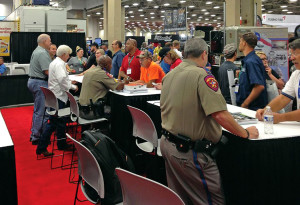Questions about Laden CMVs, California Length Laws & More Answered by Law Enforcement Officials (as of July 2017)
Warning: Laws are subject to change without notice. These interpretations were made on June 14, 2017.
Brought to you as a public service by Ol’ Blue, USA and 10-4.
Submit your questions to www.askthelaw.org
WE HOPE TO SEE YOU AT GATS IN DALLAS
 Please join our Ol’ Blue, USA “Safety Center”® at the Great American Trucking Show (GATS) in Dallas, Texas on August 24, 25 & 26 in booth 17053 and 18053. We are pleased to announce that Lt. Monty Kea and his team from the Texas Highway Patrol will be joining us in Dallas again this year. As you can see in the photo, taken last year at GATS, many drivers took advantage of the opportunity to ask their questions and/or voice their concerns about the laws and regulations they deal with on a daily basis directly to the law enforcement officials in our booth. We are here to help, not harass, so come by and talk to one of our friendly and educated troopers. Photo by Monty Dial.
Please join our Ol’ Blue, USA “Safety Center”® at the Great American Trucking Show (GATS) in Dallas, Texas on August 24, 25 & 26 in booth 17053 and 18053. We are pleased to announce that Lt. Monty Kea and his team from the Texas Highway Patrol will be joining us in Dallas again this year. As you can see in the photo, taken last year at GATS, many drivers took advantage of the opportunity to ask their questions and/or voice their concerns about the laws and regulations they deal with on a daily basis directly to the law enforcement officials in our booth. We are here to help, not harass, so come by and talk to one of our friendly and educated troopers. Photo by Monty Dial.
MAXIMUM LENGTH LAWS IN CALIFORNIA
Q: I received a citation for VC35401(A). The officer said the maximum length of a tractor and trailer is 65 feet. Most haulers use 53-foot trailers and a conventional tractor. Is the law 65 feet? If so, most haulers would be getting citations. Please advise – Bob in California
A: Provided by Sergeant Jaime Nunez, California Highway Patrol, Commercial Vehicle Section, Sacramento, CA: California Vehicle Code (CVC) Section 35401(a) requires vehicle combinations to be 65 feet or less. However, Section 35401.5(a) CVC provides an exemption to the 65-foot limit for combinations consisting of a truck tractor and semi-trailer on certain California truck routes. California’s truck routes are available at www.dot.ca.gov. Additionally, vehicle combinations that contain a trailer longer than 48 feet must maintain a king pin to rear axle setting of 40 feet or less.
PROPER DEFINITION OF A LADENED CMV
Q: I would like to request a more detailed definition of what would be considered a “laden” and an “unladen” CMV. After I am relieved from dispatch and motor carrier responsibilities, am I allowed to drive to the nearest truck stop/rest area with an empty trailer being off duty, or does that only apply to the tractor by itself? Thanks – Alan in Texas
A: Provided by Senior Trooper Monty Dial (Ret.), Texas Highway Patrol, Commercial Vehicle Enforcement Division, Garland, TX: You have asked a good question. Nowhere in the DOT regulations does it define what a laden vehicle is. There are some examples of what a driver can and cannot do if the vehicle is laden, but those examples are limited to a vehicle being loaded with hazardous materials. There are those in the enforcement community that say a vehicle is ladened if it has a trailer, regardless of whether the trailer is loaded or empty, while others say that a trailer is ladened only if it is loaded. Whose definition is right or wrong remains the interpretation of the trooper/inspector who has you stopped. There is one interpretation, found in Part 395.8 Question #26, which says that a driver is allowed to drop their trailer and bobtail to various locations (food, entertainment or shopping) while en route or once the driver reaches a location and drops their trailer and bobtails home and back to the location of their trailer before starting their next trip. But, another interpretation, found in Part 395.2 Question #1, states that all time spent at the controls of a CMV are to be recorded as driving time from the last stop to home. So, based on not being able to find a definition of what a “ladened” vehicle is and with the two examples used, I cannot give you an answer that is going to be fool-proof. What I mean is, I cannot give you an answer that’s going to keep you from possibly getting written up for moving from your last drop to the nearest truck stop or rest area.
~ The Ask The Law™ programs are an ongoing educational effort between Ol’ Blue, USA™ and commercial law enforcement agencies. Ol’ Blue, USA is a non-profit organization dedicated to highway safety education and to improving relations between the motoring public, law enforcement and commercial drivers. “Ask The Law” is a registered trademark of Ol’ Blue, USA. This column is copyrighted© by Ol’ Blue, USA. Warning: Laws are subject to change without notice. These interpretations were made on June 14, 2017.
